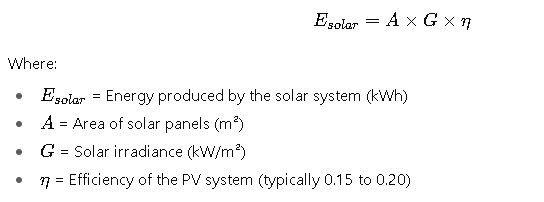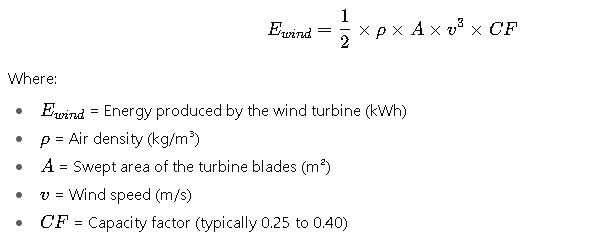The integration of solar and wind energy provides reliable, efficient solutions to meet fluctuating energy demands. Combining these resources reduces fossil fuel dependency, optimizes grid performance, and ensures consistent renewable energy supply.
Combined Solar & Wind Energy Calculator
How is combined energy calculated?
What are effective hours?
Why consider both sources?
1. Common Values for Combined Solar and Wind Energy Systems
To facilitate the design and analysis of hybrid energy systems, it’s essential to understand the typical values associated with solar and wind energy generation. Below is a table summarizing these values:
| Parameter | Solar Energy (PV) | Wind Energy (Onshore) |
|---|---|---|
| Capacity Factor | 15% – 25% | 25% – 40% |
| Average Daily Generation | 3 – 5 kWh/kWp | 4 – 6 kWh/kW |
| Seasonal Variation | High (summer peak) | Moderate |
| Intermittency | Moderate | High |
| Typical System Size | 1 – 100 MW | 1 – 100 MW |
| Storage Requirements | High (due to daily cycles) | Moderate (due to variability) |
| Grid Integration Complexity | Moderate | High |
| Typical Applications | Residential, Commercial | Utility-scale, Industrial |
2. Formulas for Calculating Combined Solar and Wind Energy
To accurately assess the combined energy output from solar and wind systems, several key formulas are employed:
2.1. Solar Energy Generation
The energy generated by a solar photovoltaic (PV) system can be calculated using:

2.2. Wind Energy Generation
The energy produced by a wind turbine is given by:

2.3. Combined Energy Output
The total energy output from the hybrid system is the sum of the individual contributions:
2.4. Demand Matching
To ensure the combined system meets the energy demand (DDD) over a specific period, the following condition must be satisfied:
Where:
- D= Energy demand (kWh)
3. Real-World Applications
3.1. Kennedy Energy Park, Australia
The Kennedy Energy Park in Queensland, Australia, is a notable example of a hybrid solar-wind energy system. The first stage of the project, commissioned in 2023, consists of:
- 30 MW of wind turbines
- 20 MW of single-axis tracking solar panels
- 2 MW of lithium-ion battery storage
This combination allows for a more stable and reliable energy supply, reducing reliance on fossil fuels and enhancing grid resilience.
3.2. Gujarat Hybrid Renewable Energy Park, India
Located in Kutch district, Gujarat, this park is under construction and is expected to be the world’s largest hybrid renewable energy park. Once completed, it aims to generate 30 GW from solar panels and wind turbines, enough to power 18 million Indian homes.
4. Optimization Techniques
To enhance the efficiency and reliability of combined solar and wind energy systems, several optimization strategies are employed:
- Hybrid System Sizing: Determining the optimal capacity of solar and wind components to meet demand while minimizing costs.
- Energy Storage Integration: Incorporating battery storage to manage intermittency and ensure a stable energy supply.
- Advanced Forecasting: Utilizing meteorological data to predict energy generation and demand patterns, enabling proactive management.
- Grid Management: Implementing smart grid technologies to efficiently distribute energy and respond to fluctuations in supply and demand.
5. Challenges and Considerations
While hybrid solar-wind systems offer numerous benefits, several challenges must be addressed:
- Intermittency: Both solar and wind energy are variable, requiring effective storage solutions and grid management.
- High Initial Costs: The installation of hybrid systems can be capital-intensive, though operational costs are generally lower.
- Regulatory Hurdles: Navigating permitting processes and ensuring compliance with local regulations can be complex.
- Environmental Impact: Assessing the ecological effects of large-scale installations is crucial to minimize negative consequences.
6. Future Outlook
The future of combined solar and wind energy systems is promising, with advancements in technology and increasing global emphasis on renewable energy. Ongoing research focuses on improving efficiency, reducing costs, and enhancing integration with existing energy infrastructure. As these systems become more prevalent, they are expected to play a significant role in achieving global sustainability goals.
For further reading and detailed studies on hybrid renewable energy systems, consider exploring the following resources:
- A review of hybrid renewable energy systems: Solar and Wind
- Modeling and Analysis of a 12kW Solar-Wind Hybrid System
- Hybrid solar, wind, and energy storage system for a remote community
These articles provide in-depth analyses and case studies that can enhance understanding of hybrid energy systems.

